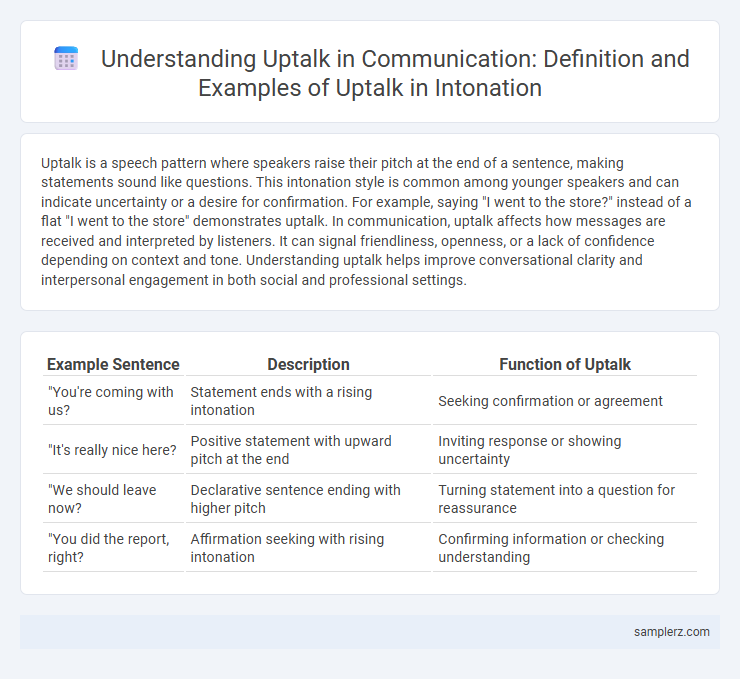Uptalk is a speech pattern where speakers raise their pitch at the end of a sentence, making statements sound like questions. This intonation style is common among younger speakers and can indicate uncertainty or a desire for confirmation. For example, saying "I went to the store?" instead of a flat "I went to the store" demonstrates uptalk. In communication, uptalk affects how messages are received and interpreted by listeners. It can signal friendliness, openness, or a lack of confidence depending on context and tone. Understanding uptalk helps improve conversational clarity and interpersonal engagement in both social and professional settings.
Table of Comparison
| Example Sentence | Description | Function of Uptalk |
|---|---|---|
| "You're coming with us? | Statement ends with a rising intonation | Seeking confirmation or agreement |
| "It's really nice here? | Positive statement with upward pitch at the end | Inviting response or showing uncertainty |
| "We should leave now? | Declarative sentence ending with higher pitch | Turning statement into a question for reassurance |
| "You did the report, right? | Affirmation seeking with rising intonation | Confirming information or checking understanding |
Understanding Uptalk: Definition and Characteristics
Uptalk, also known as rising intonation, is a speech pattern where the pitch of the voice rises at the end of statements, making them sound like questions. This intonation is common among young speakers and often signifies uncertainty, politeness, or a desire for affirmation. Understanding uptalk helps improve communication by recognizing cues of engagement, hesitation, or seeking feedback in conversations.
The Role of Uptalk in Modern Communication
Uptalk, characterized by a rising intonation at the end of statements, plays a crucial role in modern communication by signaling uncertainty, politeness, or seeking affirmation. This speech pattern often fosters engagement and inclusivity, making conversations appear more collaborative and open-ended. In digital communication and professional settings, strategic use of uptalk can enhance perceived approachability and encourage interactive dialogue.
Common Contexts Where Uptalk Occurs
Uptalk, characterized by a rising intonation at the end of statements, frequently appears in casual conversations among young adults and teenagers, signaling uncertainty or seeking affirmation. This speech pattern is common in customer service interactions where employees use it to engage customers and convey friendliness. Uptalk also occurs in educational settings, particularly among students trying to validate their responses or opinions during discussions.
Uptalk Examples in Everyday Conversation
Uptalk often appears in everyday conversation when speakers raise their pitch at the end of declarative sentences, creating an impression of questioning rather than stating. For example, someone might say, "I went to the store yesterday?" or "It's really cold outside?" despite making factual statements. This intonation pattern is common in informal settings and can convey uncertainty, seek affirmation, or foster engagement during communication.
Uptalk in Professional and Academic Settings
Uptalk, characterized by a rising intonation at the end of statements, often signals uncertainty or a need for confirmation in professional and academic settings. This speech pattern can inadvertently undermine a speaker's authority and credibility, influencing perceptions during presentations or meetings. Effective communication in these environments typically benefits from a confident, steady tone to convey clarity and assertiveness.
Cultural Variations in Uptalk Usage
Uptalk, characterized by rising intonation at the end of statements, varies significantly across cultures, with Australian English speakers often using it to convey engagement or politeness, while in American English it may signal uncertainty. Research indicates that in some Scandinavian countries, uptalk functions as a pragmatic tool to invite feedback, contrasting with its perception in British English as a sign of insecurity. Understanding these cultural nuances in uptalk usage enhances effective interpersonal communication and reduces potential misunderstandings.
Gender Differences in Uptalk Patterns
Research shows women are more likely to use uptalk, a rising intonation at the end of statements, signaling engagement or seeking affirmation. Studies indicate this pattern functions differently across genders, with women using uptalk to foster connection and men often using it less frequently, sometimes to avoid sounding uncertain. These patterns reflect social communication roles where intonation conveys subtle cues about confidence and social intent.
Social Perceptions and Misinterpretations of Uptalk
Uptalk, characterized by rising intonation at the end of declarative sentences, often leads to social perceptions of uncertainty or lack of confidence despite the speaker's actual intent. This intonation pattern is frequently misinterpreted as a question, causing listeners to doubt the speaker's authority or expertise. Research shows that such misinterpretations can impact professional credibility and hinder effective communication in both casual and formal settings.
Uptalk in Popular Media and Public Speaking
Uptalk, characterized by rising intonation at the end of statements, frequently appears in popular media such as reality TV shows and podcasts, where it conveys friendliness and approachability. In public speaking, speakers sometimes use uptalk to engage audiences and invite interaction, though overuse may undermine perceived authority and confidence. Studies reveal that strategic use of uptalk enhances relatability without sacrificing professionalism in communication contexts.
Strategies for Identifying and Addressing Uptalk
Uptalk, characterized by a rising intonation at the end of declarative sentences, can create ambiguity in communication by making statements sound like questions. Strategies for identifying uptalk include monitoring speech patterns for frequent pitch rises and seeking feedback from listeners about perceived uncertainty. Addressing uptalk involves practicing varied intonation through voice modulation exercises and increasing awareness of sentence-final pitch to convey confidence and clarity.

example of uptalk in intonation Infographic
 samplerz.com
samplerz.com